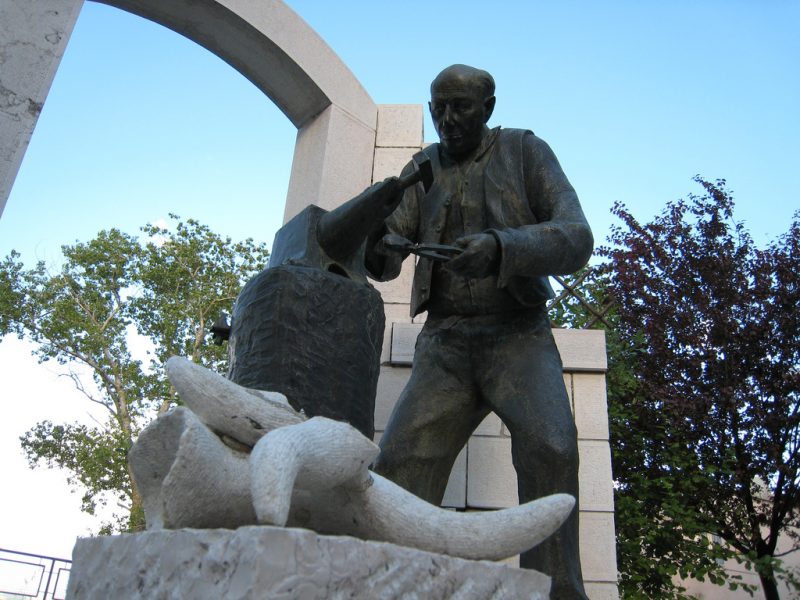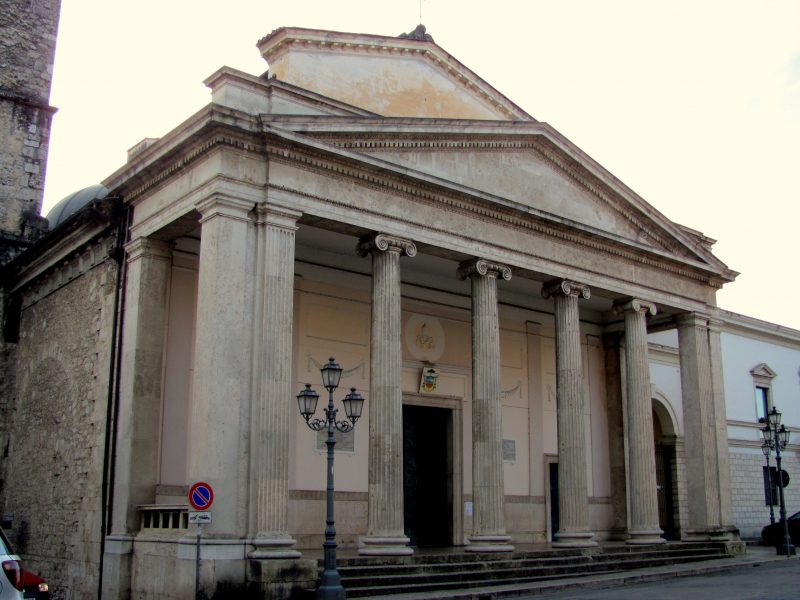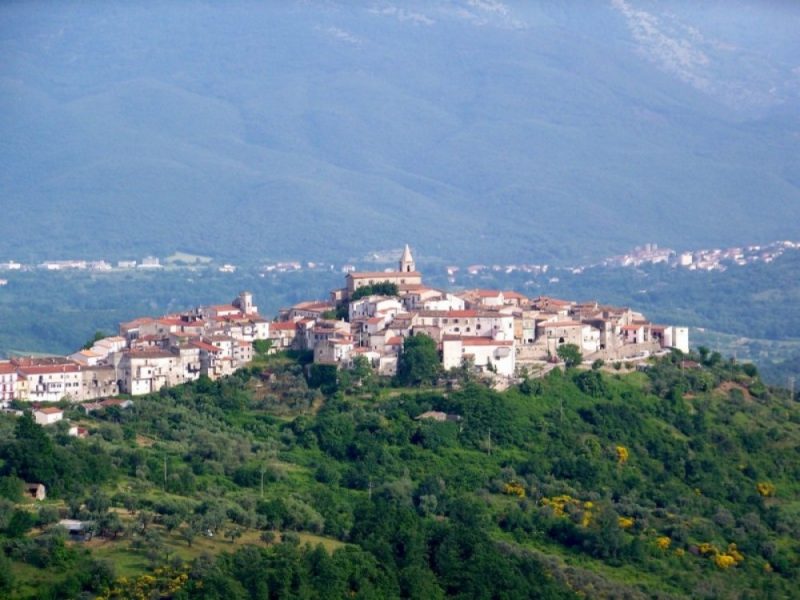The Borgo of Pietrabbondante
The ancient theater of Pietrabbondante perches over the surrounding valley full of fragrant green woods. Refreshed by the clean mountain air, the entire borgo is surrounded by this magnificent panorama of high mountains and lush green plains.
The lanes of Pietrabbondante recount an ancient past, a story more than two thousand years old, as told by the stones from the ancient Samnite village set in the walls of the Medieval houses.
Pietrabbondante is a small village, protected by the three “morge”, three massive rock formations that loom protectively behind the town, highlighted against the white façade of the Church of the Assunta.
Pietrabbondante is singular and unique, where you breathe an air of genuine and timeless traditions, to be experienced in the authentic cuisine, the delicious scent floating through streets resonating with children’s laughter and the joyful chatter of their mothers as they prepare the midday meal.
History
Pietrabbondante’s name (‘abundant stone’ in Italian) is closely linked to the surrounding territory, full of rock formations and massive karstic boulders. The first human settlements in the area date back to prehistoric times. In the sixth century BC, the Samnite population subdued all the surrounding villages and the area took the name of ‘Bovianum’. The Samnites dominated the South of Italy culturally and linguistically for centuries, until the expansionist ambitions of Rome represented an adversary whose singular determination would eventually lead to the downfall of this proud and valorous nation. The Roman desire for conquest was unquenchable, and after three violent incursions, known as the Samnite Wars, the city fell under Roman jurisdiction. The name of the town was changed to ‘Bovianum Vetus’ and only in the eighth century, with the conquest of the city by the Lombards, did it become ‘Petra Habundante’.
The current city plan of Pietrabbondante coincides with the previous Roman municipality, but slightly higher up on the rocky ridges of Mount Saraceno, are the ruins of an ancient Samnite city, that was once the most important political and religious center in the area.
During the Middle Ages and the transition into the feudal period, Pietraabbondante became the capital of thirty-four counties in the Duchy of Benevento. As often happened, the fiefdom became part of the property and interests of various feudal lords, such as the Borello family, the Carafa family and the D’Alessandro dynasty.
Today, the magnificent landscape surrounding the town and the presence of an important archeological site, have made Pietrabbondante one of the most popular destinations in Molise.
The Theater and the Temple-The Archeological Site of Pietrabbondante
On the slopes of Mount Saraceno near Pietrabbondante stand the ruins of an ancient Samnite center,
which, between the second century BC and 95 AD was once the hub of the religious functions and political activities of the Samnite people. The ruins are mainly composed of a temple and a theater, where the meetings of the Senate were held to deliberate on important issues. Next to these are the ruins of a much smaller temple and some some workshops, dating back to the beginning of the second century BC.
In order to construct these two important buildings, the Samnites created two terraces on the side of the mountain, one above the other, but in line with each other, oriented in an east/south-east position, following the course of the sun, to auspiciously greet the dawn every morning.
The theater was constructed at the same point where there had been an Ionic temple dating back to the third century BC, which was destroyed in 217 BC by the fury of Hannibal. The structure of the theater was essentially composed of two elements, the cavea, for public seating, and the stage area, joined by two arches placed at the ends of the stage. The theatre was equipped to host around two thousand five hundred spectators, where every person could enjoy a perfect acoustical experience, regardless of where they were sitting.
The seats were made from a single block of stone, with an elegantly sculpted backrest and the rows closed with two armrests with carved griffins. The first three rows were reserved for the highest authorities, usually magistrates and priests.
The stage floor was made of wood, and on the sides of the stage there were two holes with wooden rods passing through, which were then fixed in underlying stone blocks, a complicated mechanism used to make set changes on the stage.
Behind the theater stood the temple, of which today remains only the podium, or raised floor area. Eight columns once stood along the lateral walls, surmounted by Corinthian capitals and wooden epistles covered in terracotta decorations.
In the back of the temple there were three cells, which today would be called chapels, with white mosaic flooring. Each cell was dedicated to a single deity. Three altars were found between the theater and the temple, also dedicated to the gods, one of which was probably the deity of Victory, as can be guessed by an engraving found during the excavations. To the left of the altars there is an inscription in the Samnite’s language, ‘Oscan’, mentioning Azio Claro as the sponsor of half of the podium.
This site was already abandoned to neglect in the second century AD, and was completely covered with stone shards and debris. The restoration of the area was carried out in various phases, beginning in 1857, during the Spanish reign of the Bourbons and concluding in the second half of the 1900’s at the behest of the Archeological Superintendence of Molise.
The Church of Santa Maria Assunta in Cielo
On August 15, the entire community of Pietrabbondante celebrates ‘Maria Assunta in Cielo’ (the Assumption of Mary in Heaven), one of the most important holidays for the entire borgo, celebrated according to an ancient tradition which requires that during the procession through the village, the statue of the Madonna should be carried only on the shoulders of the women of the town.
For the rest of the year, the church dedicated to the Virgin watches the days go by from its tranquil heights overlooking a panorama of woods and valleys. The church is reached by climbing a stone staircase, which brings you to a simple and linear façade flanked by a square bell tower with three arched bell alcoves in the upper masonry. The simplicity of the white façade contrasts with two elements in Baroque style: in the lower part, the portal is decorated with garlands and flowers, surmounted by a niche with an ancient painting, probably Maria Assunta, and above, a large window, also framed by Baroque floral motifs. The windows running along the side of the church fill the interior with an intense light. The Latin Cross floor plan is divided into three naves surmounted by two series of arches supported by square pillars.
The most unique work of art in the church is a painting in the right transept by Father Angelico Zarlenga, which depicts the moment that Pietrabbondante was almost destroyed in 1943: when the Germans withdrew just before they were about to attack the town. Also depicted, are the prisoners returning from the concentration camps, symbolized by the broken chains, placed at the feet of San Vincenzo Ferreri, the protector of Pietrabbondante.
‘Monumento dei Caduti’ The War Memorial and love for country
Today, love for one’s place of origin is felt less intensely than in past centuries.
The elders of Pietrabbondante felt this love deeply, as did the emigrants in America who remained connected by an unbreakable bond of love to their place of birth in Molise. So much so, that as soon as the First World War ended, the emigrants organized a fundraising committee to commission a memorial commemorating the sacrifice of the many citizens of Pietrabbondante who lost their lives serving their country. In 1920, the committee was also established in Pietrabbondante, and as soon as they had collected 30,000 lire, they contacted the sculptor Giuseppe Guastalla, a teacher at “Regio Istituto Superiore di Belle Arti” in Rome. The professor created a sculpture of a Samnite warrior, as the committee had requested, with the intent of honoring the citizens who had fought in the war and also paying homage to the ancient population that founded borgo thousands of years ago.
The sculpture cost 48,000 lire, and the additional funds needed came from continual donations from the emigrants in America, and also from some local students, who founded a theater company that performed during the school holidays and donated their entire proceeds to the committee.
The eight quintals of bronze necessary for the statue were partly donated and partly sold at a discount price by the War Ministry, thanks to the interest of Minister Pietravalle.
‘Mpaniccia
The traditional cuisine of Pietrabbondante is closely linked with the rural traditions and local products of the area, as well as the town’s flourishing activity of animal herding and breeding. High quality cheeses and cured meats are the masters of the table, but the area of this borgo in Molise is also well known for its excellent truffles.
The most famous dish in Pietrabbondate is the ‘Mpaniccia, based on the products of the earth, a rich and nutritious dish perfect for warming and energizing the cold winter days.
Ingredients:
- 1kg of corn flour;
- Extra virgin olive oil as needed;
- Field vegetables, usually beets and chicory;
- Salt as needed;
- A clove of garlic;
- Water as needed;
- Sweet or spicy dried peppers (according to taste).
Preparation:
After cleaning the vegetables, boil them in a pot with water and salt. Once they are boiled, take a non-stick frying pan, add a little oil, the clove of garlic and the dried peppers and pour in the drained vegetables, then cook at medium heat for about ten minutes. In a mixing bowl, mix the corn flour with hot water and a drizzle of oil and knead until a homogeneous but not excessively soft mixture is obtained. Next, grease a baking pan with a little oil and roll out the dough, which will be baked at 180° centigrade for about an hour, or until the inside is completely baked.
When it is ready, break up the baked dough and add it to the vegetables, and if you like, add cubed ham. To be served steaming hot.
_________________________________
Do you known other typical recipes related to this borgo? Contact us!

 Italiano
Italiano
 Deutsch
Deutsch









